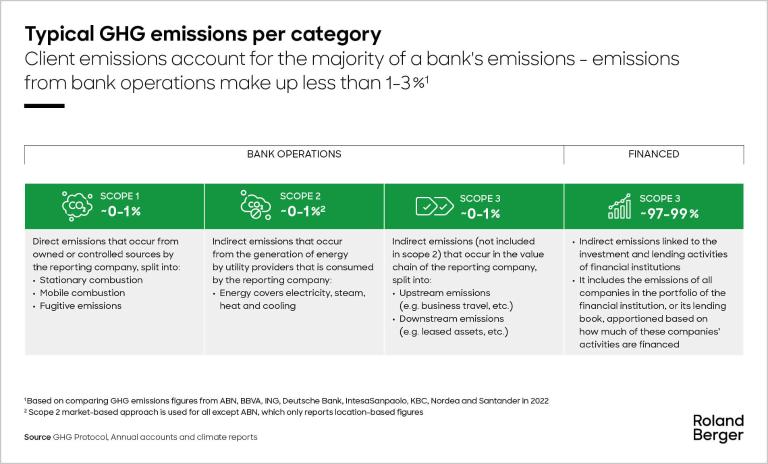Roland Berger conducted a survey among 1,000 customers of Dutch banks which shows that 95% foresee an important role for banks in accelerating sustainability.


Navigating the green path to zero
Ranking European Banks on their carbon emissions
In pursuit of a sustainable future, European banks are prioritizing and intensifying efforts to reduce their operational carbon footprint and influence their clients’ emissions. This article delves into the carbon reduction initiatives of the top-20 European banks, offering insight into their commitments to zero, their current carbon positions, and their progress in the green path to zero.

Though rating agencies are recognizing European banks for their overall sustainability ambitions, governance structures and efforts, we believe there remains substantial room for improvement.
First, in line with the new CSRD regulation on reporting, the quality of reporting on carbon emissions can be significantly improved. Today, focus primarily centers on scope 1 emissions, providing a good basis for assessing where banks currently stand. Scope 2 reporting lacks consistency across banks, therefore making it difficult to pin down accurate figures. Scope 3 reporting is very limited and does not yet cover all loan portfolios or assets under management – but generally speaking, scope 3 makes up 97-99% of the total carbon emissions a bank needs to report.

Ranking banks on scope 1 carbon emissions
Though all banks are taking steps towards becoming more sustainable, where they stand on scope 1 emissions varies. The bank with the lowest intensity reported scope 1 at 0.02 tCO2e per FTE, while the bank with the highest intensity reported 0.62 tCO2e per FTE. In general, we see that banks with already low scope 1 emissions also realized relatively high improvements in 2022.
That being said, 15 of the 20 banks reported improvements in their scope 1 emissions between 2021 and 2022, indicating sector-wide commitment to reducing operational carbon footprints. Reduction programs include best practices such as accounting for offices and branches and adopting travel policies. Moreover, investments in energy efficiency, such as LED sensor lighting systems, solar panels, and upgrading heating, cooling and ventilation systems, are being widely adopted.

First insights into scope 3: Unveiling the carbon footprint of mortgages
Assessing the emissions of mortgage portfolios among reporting banks reveals that differences in emissions intensity are closely related to underlying mortgage compositions. Top-performing banks tend to have higher concentrations of their mortgage portfolios in countries that excel in energy efficiency, such as the Nordics. Conversely, low-performing banks have more density in areas with relatively lower energy efficiency, like the UK and Eastern Europe, or have mixed portfolios featuring both high and low efficiency countries.The real challenge is how to create a path to zero which is feasible and actionable, as well as attractive for homeowners. Countries with already more energy efficient housing show that there is room for improvement, but also that there is still a long way to go.
Emissions intensity in corporate loans
Assessing the emissions of loans to corporate clients reveals that banks have widely varying emissions intensity levels. A bank’s sector focus drives these differences, with banks exposed to more emissions-intense sectors exhibiting higher intensity. The challenges a bank faces in this area will largely depend on that bank’s particular corporate loan portfolio, but all banks will have to make their own propositions and action plans to support their companies in becoming carbon neutral, or at least incentivize them to reduce emissions. In-depth sector knowledge will support banks’ success on this journey, and could require them to finetune their current portfolio mix.
Conclusion
European banks are fully aware of their responsibilities in creating a more sustainable world. Although banks are taking action, they currently provide little transparency into their plans, especially on their scope 3 paths to zero. We believe that there is still a long way to go, and banks should accelerate their efforts to reduce scope 3 emissions. Importantly, they can depend on their clients here. New solutions and adapted products, policies, risk models and processes will equip banks to proactively support clients on their own paths to zero. Banks’ green targets will inevitably follow.



